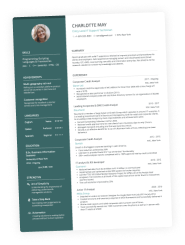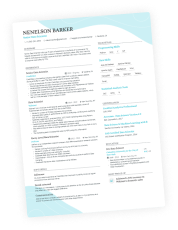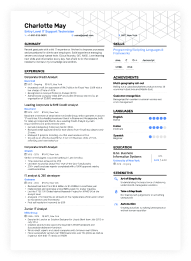According to recent resume stats, video resumes are slowly but surely reshaping job recruitment. With TikTok-style job applications popping up, the big question is: Are video resumes more like quick social clips or polished, professional resumes?
If you’re making one, you’ve got to get it right. A video resume amplifies everything—your confidence, your energy, and yes, even your missteps. A weak one won’t just be ignored—it could leave the wrong impression long before you get to an interview.
This guide will show you how to create a video resume that gets the right kind of attention—and helps you land the job.
Key takeaways
- Only create a video resume if it’s truly needed—stick to industries where it adds value or when an employer specifically requests one.
- A video resume should be short and engaging—stick to up to 90 seconds to hold the recruiter’s attention.
- Use a clear script with a strong introduction, key achievements, and a confident call to action.
- Good lighting, clear audio, and a distraction-free background make a big difference.
- Editing should enhance, not distract—trim unnecessary parts, add subtle text overlays, and avoid excessive effects.
- Send your file or URL directly to employers in the preferred format.
What is a video resume and should you make one?
A video resume is a job application format that lets you pitch yourself on camera instead of just on paper. It’s exactly what it sounds like—a short video (ideally 60–90 seconds) where you introduce yourself, highlight your skills, and explain why you’re the right fit for the job.
Unlike a traditional resume, which relies on written words alone, a video lets hiring managers see and hear you in action before you ever step into an interview.
That’s a double-edged sword. A well-made video resume can make you memorable in a way a written one can’t. A bad one could work against you.
When do video resumes work?
If you’re in a field where presentation, communication, or creativity matter, a video resume could be your secret weapon. It shows employers who you are before they ever meet you.
It also allows you to articulate:
- Your personality: A big plus for roles where attitude and energy make a difference, like hospitality, events, or customer service.
- Your communication skills: Essential for sales, media, and leadership positions where how you speak matters as much as what you say.
- Your creativity and confidence: A strong advantage in design, entertainment, or client-facing roles where first impressions count.
PRO TIP
A filmed resume won’t replace your traditional one. Most companies still expect a written format, so think of your video as a way to enhance your application—not replace it.
Who benefits from a video resume?
Video resumes aren’t for every job, but in the right industries, they can give you an edge.
Best for:
- Creative fields: video editors, designers, content creators.
- Marketing and media: social media managers, PR professionals, journalists, news anchors.
- Customer-facing roles: sales, customer service, hospitality, real estate, retail, client relations.
- Startups and modern companies that value personality as much as skills.
Not ideal for:
- Highly technical roles such as software engineers, data analysts, accountants.
- Corporate and finance jobs, where structured applications are the norm.
- Industries that rely on applicant tracking systems (ATS), since video content isn’t scanned by hiring software.
That said, the biggest factor in deciding whether to make a video resume isn’t personal preference—it’s the employer’s expectations. If a company specifically requests one—make it—and make it great. Otherwise, there’s no pressure to create one.
PRO TIP
Some candidates like to keep a video version of their resume as a nice-to-have, sharing it publicly on their personal website or LinkedIn as an extra layer of visibility. While that might sound like a smart move, it’s not always the best idea—and we’ll explain why later in this article.
For now, just know this: unless a video resume is explicitly required, it’s entirely optional.
Next, let’s dive into the step-by-step process of filming a video resume.
How to make a video resume in 6 steps
A video resume isn’t just about hitting the record button and talking about yourself—it needs structure and a clear message. Unlike a traditional document, where recruiters can scan for key details, a video resume needs to capture attention quickly and hold it. That’s why planning is the most important part.
Before you start filming, you need to know exactly what to say, how to say it, and how to make it relevant to the job you’re applying for.
Step 1. Write your video resume script
Just like you wouldn’t submit a resume full of random facts about yourself, you shouldn’t ramble in a video resume either. Your script should be tailored to the job description—highlighting the specific skills and experience that align with what the employer is looking for.
Here are the recommended sections of a video resume:
An introduction or setting the stage
Start with a confident, straight-to-the-point introduction. Think of it like the opening of a cover letter—but far less formal.
You need to say:
- Your name.
- Your job title or background.
- The role you’re applying for.
Here’s how a social media manager might kick off their video resume:
“Hi, I’m Jordan Lee, a digital content creator and social media enthusiast with a passion for building brands through engaging video content. I’m excited to apply for the Social Media Content Creator role at Real Energy because I love creating dynamic, on-trend videos that connect with audiences and drive engagement…”
Your value or what makes you a great hire
This is where you tie your experience and skills to what the employer needs. Don’t just list job titles—show what you bring to the table.
For the best impact, keep this section concise and results-driven. Whenever possible, use numbers, achievements, or real outcomes—just like you would in your resume’s work experience section.
As in the following:
“…Over the past year, I’ve grown my personal TikTok following to 50K by creating viral fitness and lifestyle content. I know how to tap into trends, craft engaging short-form videos, and spark conversations that keep audiences coming back. Plus, I thrive in fast-paced environments and love the challenge of building a brand from the ground up…”
Your hook or what makes you different
Here’s where you add a memorable detail that sets you apart. Think of this as the part of your video that sticks with the hiring manager after they’ve already watched ten other applications.
What works? A unique achievement, passion project, or a skill that isn’t obvious from your resume but strengthens your application.
“…I don’t just create content—I study what makes videos go viral. I’ve tested everything from trending audio to bizarre jump-cut edits, and once got a local gym’s engagement to skyrocket by turning their receptionist into a meme. That post alone doubled their followers in a week. I bring that same data-driven, creative mindset to everything I do…”
Call to action—close strong
Wrap things up with confidence and a clear next step:
- Thank the viewer for their time.
- Express enthusiasm for the role.
- Let them know how to contact you.
Here’s an example:
“I’d love to bring my creativity and social media expertise to Real Energy and help turn your brand into the next big thing. If you’re looking for someone who can ride trends and create content that actually gets people talking, let’s connect!
You can reach me via email or LinkedIn—oh, and if you want proof of my work, just check out my latest post.
See you there!”
PRO TIP
Write your script like you’re speaking to a real person—not reading off a teleprompter. However, keep in mind you still need to hook them in the first 10 seconds. Hiring managers scroll through video applications just like social media feeds—if you don’t grab their attention fast, they’ll move on.
Step 2. Get your set-up ready
A video resume isn’t just about what you say. It’s about how you look and sound while saying it. Unlike an in-person interview, where body language and presence naturally hold attention, a video requires extra effort to make everything feel authentic through the screen.
That means you can’t afford bad lighting, muffled audio, or a grainy picture. If your video is hard to watch or listen to, recruiters will tune out—no matter how great your message is.
The art of virtual presence
Think of your video resume like a virtual presentation—because, in many ways, it is. How often have you zoned out of a Zoom call because you couldn’t hear the presenter properly, or worse, they had their camera off? 😱
In today’s world, keeping an audience engaged through a screen is a skill in itself—one that many jobs rely on daily. Your video resume is a chance to show that you know how to command attention through a professional setup—just like you would in any online meeting.
Here’s how to make sure your equipment is working for you, not against you:
- Camera: A smartphone with 1080p or 4K resolution is more than enough—just make sure it’s stable (use a tripod or prop it up).
- Lighting: Good lighting makes all the difference—natural light is ideal—just make sure you’re facing it to avoid being backlit. If that’s not an option, a ring light or a well-placed lamp will give you a clean, professional look.
- Sound: Clear audio is non-negotiable. Record in a quiet room, turn off background noise (like fans or AC), and if possible, use an external mic—even a basic one can drastically improve sound quality.
- Background: Keep it clean, simple, and free of distractions—a neutral-colored wall works best. If a tidy spot isn’t an option, a virtual background can work as long as it looks natural (forget the sunsets and beaches—it’s a job resume after all).
Many experienced video creators curate their backdrop with small details that reflect their personal brand or interests—like neatly arranged books, subtle decor, or prints of iconic brands and figures. Just make sure it enhances your presence rather than compete for attention.
- Dress code: Look the part. Match your outfit to the industry—smart casual for creative roles and polished but relaxed for startups. Just because you’re filming from home doesn’t mean you should look like it.
Step 3. Rehearse
Public speaking and videoconferencing have one thing in common—confidence comes with repetition.
Record a few practice runs and watch them back. If something feels off—whether it’s your energy, eye contact, or pacing—you’ll catch it and improve before the real take. The more you rehearse, the more naturally your personality and expertise will come through.
Practicing a few times will help you:
- Refine your tone and pacing—so you don’t sound rushed or robotic.
- Eliminate filler words and awkward pauses, making your message clearer.
- Feel more at ease on camera which translates to a more professional impression.
PRO TIP
Eye contact builds connection—even through a screen. When you look directly at the camera, it creates the illusion of speaking face-to-face, making your message feel more personal.
If this doesn’t come naturally, place a sticky note near your camera as a reminder or imagine you're speaking directly to a person on the other side.
Once you’ve cut out the “uhs” and “ums” and feel comfortable with your delivery, it’s time to hit record.
Step 4: Record your video resume
Recording might feel nerve-wracking at first, but remember—you’re in control. You can redo takes and fine-tune your delivery until it feels right.
Here’s how to make the most of this experience:
How to make a video resume
Frame yourself like a pro
- Position the camera at eye level for a natural, engaging angle.
- Keep your face well-lit and centered—your eyes should be about one-third from the top of the frame.
- If you’re using a smartphone, record in landscape mode (unless it’s for TikTok or another vertical-friendly platform).
Speak with energy and clarity
- Smile and project confidence—your energy needs to come through the screen.
- Speak clearly and at a steady pace—don’t rush or drag.
- Keep your delivery engaging but natural—like you’re having a conversation, not reciting a script.
Don’t be afraid of multiple takes
- Your first take won’t be perfect—and that’s okay. Record a few versions and compare.
- Watch your playback and check for lighting, sound clarity, and delivery.
- If you trip over a word or lose your train of thought, pause, reset, and keep going.
Your goal isn’t perfection—it’s authenticity. If you sound overly rehearsed, it’ll feel stiff. If you’re too casual, it might not come across as professional. Find that sweet spot where you’re confident, clear, and personable.
Once you’re happy with your recording, you’re ready for the final step—editing your video into a refined, job-ready resume.
Step 5. Edit your video resume
Video has a natural advantage over text—it grabs attention through movement and quick frame changes, which the human brain loves. But here’s the catch: the same effect shortens our attention span.
That’s why editing is key. Your video resume needs to hit the sweet spot between engaging and overwhelming.
Here’s what to do to keep it interesting enough to hold attention, but well-crafted enough to stay professional:
- Choose the right editing tool: Beginner-friendly options like iMovie or CapCut work well, while Final Cut Pro offers more advanced features if needed.
- Trim unnecessary content: Cut out awkward pauses, filler words, or anything off-topic.
- Add text overlays: Briefly display your name and job title at the start.
- Background music (optional): A subtle, royalty-free track can make your video feel sophisticated—but keep it light and professional.
- Use effects and filters wisely: A few enhancements can illustrate personality, but too many can seem unprofessional or distracting.
PRO TIP
Subtitles increase engagement by 80%—consider adding them, especially if your role involves communication or public-facing skills. Many recruiters watch videos on mute, so captions ensure your message gets across.
Done right, editing will enhance your message, making sure you leave the right impression.
Now, onto the final question—where should I upload my video?
Step 6. Submit your video resume
As we mentioned earlier, some job seekers post their video resumes directly on their LinkedIn profile or YouTube, hoping to go viral. While this might work for content creators or those looking to build a public personal brand, it also exposes your application to a broad audience—including people who may not have the best intentions.
If you're simply introducing yourself without targeting a specific job, then posting your video on your social media or personal website could be fine—as long as you're aware of the risks.
If not, follow our tips below.
Where should your video resume go?
The best option is to send your video resume directly to the employer in the format they request.
Here’s how to do it right:
- Follow file format requirements: If the employer asks for a specific format (MP4, MOV, etc.), make sure your file is compatible and high quality.
- Choose the easiest delivery method: Sending an entire file? Name it properly and make sure it can be opened and viewed on any device. If you're sending a link to cloud storage (Google Drive, Dropbox), it has to work without extra steps.
- Check accessibility: If you're sharing via Google Drive or another platform, double-check your sharing settings so the recruiter can open it without requesting permission.
Places to share your video resume
- Directly in job applications: If the employer allows, paste the link in the designated field.
- LinkedIn: Upload as a post or add it to your profile.
- YouTube: Set the video to unlisted so only those with the link can view it.
- Portfolio website: Embed it for personal branding.
- Resume header: Some modern resume formats allow additional links, so you can place your video resume right where recruiters will see it first.
Use Enhancv’s resume builder for a neat and ATS-friendly resume.
Want to make your video resume even more accessible? Add a QR code to your paper resume or business card so recruiters can scan and watch instantly.
Video resume dos and don’ts
Video resumes only work in the right circumstances—so if you’re sure you need one, make it count.
Here’s what to keep in mind:
DOS
- Tailor your video resume to the role: Just like a written resume, your video should be job-specific and highlight the skills that matter most.
- Keep it short and engaging: 90 seconds max. Attention spans are short, so get to the point fast.
- Show, don’t just tell: A video resume isn’t just about what you say—it’s about how you say it. If you’re in sales, demonstrate persuasive speaking with confidence. If you’re a video editor, make the production quality exceptional.
- Make sure the video quality is professional: Clear visuals, crisp sound, and a well-lit setup make all the difference.
- Have someone else review it: A second opinion can help catch awkward phrasing, poor sound quality, or distractions you might not notice.
- Avoid sharing it publicly: Unless you’re a content creator, keep it private and send it directly to employers. A video resume is meant for hiring managers, not the entire internet.
DON’T
- Ramble or go off-topic: Every second counts. If a recruiter gets bored, they’ll stop watching.
- Overuse slang, niche humor, or gimmicks: Keep it professional yet authentic to your personality.
- Forget a call to action: End with how to reach you and express your enthusiasm for the role.
- Leave it on “Restricted”: Don’t make recruiters jump through hoops to access your video resume—it should open with a single click.
Frequently asked questions about video resumes
Not sure if a video resume is right for you? Or maybe you’re wondering how to make one without overcomplicating things? Here are the answers to some common questions job seekers have about video resumes.
How long should a video resume be?
Keep it short—ideally 60 to 90 seconds. Hiring managers don’t have time to sit through a full-length documentary. Get to the point fast, highlight your best selling points, and leave them wanting to know more.
What are the best tools to make a video resume?
If you're new to editing, CapCut, Canva Video Editor, and iMovie are solid beginner-friendly options. If you want more advanced features, try Adobe Premiere Rush or Final Cut Pro. But remember—the focus is on your message, not fancy effects.
For template-based, AI-assisted editing, platforms like Biteable and Veed.io help you create a polished video resume quickly—even if you have no editing experience. Biteable offers pre-made animations and text overlays, while Veed.io has auto-subtitles, background noise removal, and one-click branding tools.
How can I use AI to create my video resume?
You can definitely use AI to create a resume, and videographic ones are no exception. AI can write your script, enhance video quality, and speed up editing. Use ChatGPT to refine your talking points, Descript for AI-powered editing and audio clean-up, or Veed.io for automated captions and effects. But remember—AI is a tool, not a replacement. Your video resume should still sound like you.
Conclusion
A video resume can work in your favor—or backfire completely. It’s not for every job, and it’s definitely not a shortcut. But when done right, it can bring your application to life in a way that a written resume can’t. If your industry values personality and presentation, and you’re willing to put in the effort, a polished video resume might just be the thing that gets you noticed—and gets you hired.
Make one that's truly you.




